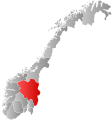Stor-Elvdal
Stor-Elvdal kommune | |
|---|---|
 Coat of arms  Innlandet within Norway | |
 Stor-Elvdal within Innlandet | |
| Coordinates: 61°38′6″N 10°52′27″E / 61.63500°N 10.87417°ECoordinates: 61°38′6″N 10°52′27″E / 61.63500°N 10.87417°E | |
| Country | Norway |
| County | Innlandet |
| District | Østerdalen |
| Administrative centre | Koppang |
| Government | |
| • Mayor (2005) | Sigmund Vestad (LL) |
| Area | |
| • Total | 2,166 km2 (836 sq mi) |
| • Land | 2,125 km2 (820 sq mi) |
| Area rank | 25 in Norway |
| Population (2004) | |
| • Total | 2,819 |
| • Rank | 283 in Norway |
| • Density | 1/km2 (3/sq mi) |
| • Change (10 years) | −12.7% |
| Demonym(s) | Storelvdøl[1] |
| Time zone | UTC+01:00 (CET) |
| • Summer (DST) | UTC+02:00 (CEST) |
| ISO 3166 code | NO-3423 |
| Official language form | Bokmål[2] |
| Website | www |
Stor-Elvdal is a municipality in Innlandet county, Norway. It is part of the traditional region of Østerdalen. The administrative centre of the municipality is the village of Koppang.
The parish of Store Elvedalen was established as a municipality on 1 January 1838 (see formannskapsdistrikt). The neighboring municipality of Sollia was merged with Stor-Elvdal on 1 January 1965.
General information[]
Name[]
The Old Norse form of the name was Elfardalr. The first element is the genitive case of elfr which means "river" (here the Glomma river) and the last element is dalr which means "valley" or "dale".[3]
The first element Stor- (meaning "big") was later added to distinguish it from the municipality of Lille Elvedalen (now called Alvdal). (In the late Middle Ages the two districts was distinguished by ytre [meaning "outer"] and øvre [meaning "upper"].)
Coat-of-arms[]
The coat-of-arms is from modern times (1988). The arms show two silver-colored two-man saws on a green background.
| Ancestry | Number |
|---|---|
| 28 | |
| 28 | |
| 26 | |
| 23 | |
| 18 |
Tourism[]
Stor-Elvdal boasts the second[5] tallest moose statue in the world, a steel giant moose at the side of the Riksvei 3 highway.

Geography[]
Stor-Elvdal is bordered on the north by the municipalities of Folldal and Alvdal, on the east by Rendalen, in the south by Åmot and Ringsaker, in the west by Øyer and Ringebu, and in the northwest by Sør-Fron.
Sister cities[]
The following cities are twinned with Stor-Elvdal:[6]
Notable people[]
- Thore Embretsen Myrvang (1858–1939) an educator and politician, three times Mayor of Stor-Elvdal
- Halldis Neegaard Østbye (1896 in Stor-Elvdal – 1983) In WWII known as "Norway's most fanatical Naziwoman"
- Torkel Andreas Trønnes (1925-2011) an automobile advocate, lived in Koppang
References[]
- ^ "Navn på steder og personer: Innbyggjarnamn" (in Norwegian). Språkrådet.
- ^ "Forskrift om målvedtak i kommunar og fylkeskommunar" (in Norwegian). Lovdata.no.
- ^ Rygh, Oluf (1900). Norske gaardnavne: Hedmarkens amt (in Norwegian) (3 ed.). Kristiania, Norge: W. C. Fabritius & sønners bogtrikkeri. p. 353.
- ^ "Immigrants and Norwegian-born to immigrant parents, by immigration category, country background and percentages of the population". ssb.no. Archived from the original on 2 July 2015. Retrieved 29 June 2015.
- ^ https://www.cbc.ca/news/canada/saskatchewan/mac-moose-tallest-moose-jaw-1.5314141
- ^ "Internasjonal kommune" (in Norwegian). Stor-Elvdal kommune. Retrieved 2008-12-30.
External links[]
 Media related to Stor-Elvdal at Wikimedia Commons
Media related to Stor-Elvdal at Wikimedia Commons The dictionary definition of Stor-Elvdal at Wiktionary
The dictionary definition of Stor-Elvdal at Wiktionary- Municipal fact sheet from Statistics Norway
- Stor-Elvdal
- Municipalities of Hedmark


